2012 VOLKSWAGEN GOLF MK6 batteries
[x] Cancel search: batteriesPage 135 of 516

Opening and closing
this section find info rmation about:
R em o
te control vehicle keys . . . . . . . . . . . . . . 37
Mec hanical key . . . . . . . . . . . . . . . . . . . . . . . . . 38
Volkswagen
Power locking and clos ing system 41
Starti ng and stopping the engine
Cons ume r inf ormat ion
Eme rgen cy closin g and opening
Always keep remote control vehicle key fobs with batteries, spare batterie s, as as
dead button mm batteries out of the reach of children.
Get medical attention immediately if you suspect that a battery has been swallowed .
use of vehicle key s can result in se-rious personal injury.
36 Before driving
Always take the key with you when you leave the vehicle . can be used to start the
engine and operate vehicle systems s uch as
the powe r windows, leading to se rious personal injury.
the vehicle is moving or to a stop. The steering wheel lock and you
Page 138 of 516
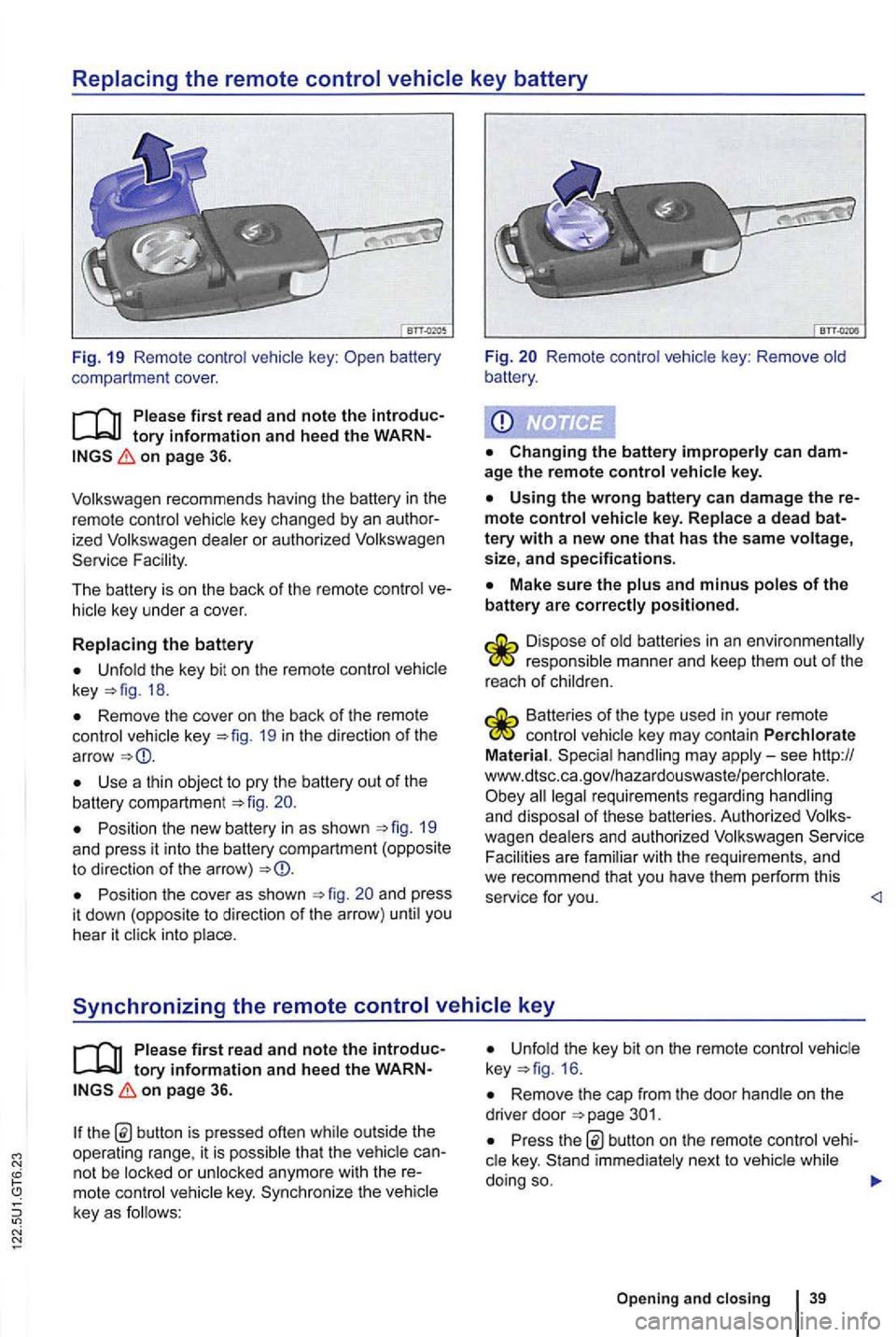
Replacing the remote control vehicle key battery
Fig. 19 Remo te contr ol key :
on page 36.
ized dealer or authori zed Service Fac ility.
The battery is on the back of the remo te control
Unfold the key bit on th e re mote control key 18.
Remove the cover on th e back of the remote control vehicle key 19 in th e d irection of th e
ar row
Use a thin object to pry the battery out of the battery compartment 20.
Position the new battery in as shown 19 and press it into the battery compartm ent (opposite to direction of the arro w)
Position the cove r as shown and press
i t dow n (oppos ite to direction of the arrow ) unti l you
hear it click into place.
Fig. Remote control vehic le key : Remove old
battery .
age the remote control vehicle key.
Using the wrong battery can damage the mote control vehicle key. Replace a dead
Make sure the plus and minus poles of the battery are correctly positioned .
responsible manner and keep them out of the
r eac h of ch ild ren.
Batteries of the type used in your re mote control veh icle key may contain Perchlorate
Material . Special handling may apply-see http://
www.dtsc .c a.go v/hazar douswaste/pe rchlo rate. all legal requirement s regardin g han dling and dispo sal of these batteries. Authorized Serv ice
Facili ties are fami lia r with the re quirements , and we recommend that you have them perform this
service for you.
tory information and hee d the on page 36.
th e b utton is pressed often while out side the
operating range, it is p ossib le tha t the vehicl e
key. Sy nchr oniz e the veh icle
key as f o llows:
Unfold the key bit on the remote control 16 .
Remove the cap from the door hand le on the
drive r door
Pr ess button on the remote cont rol
Opening and closing 39
Page 337 of 516
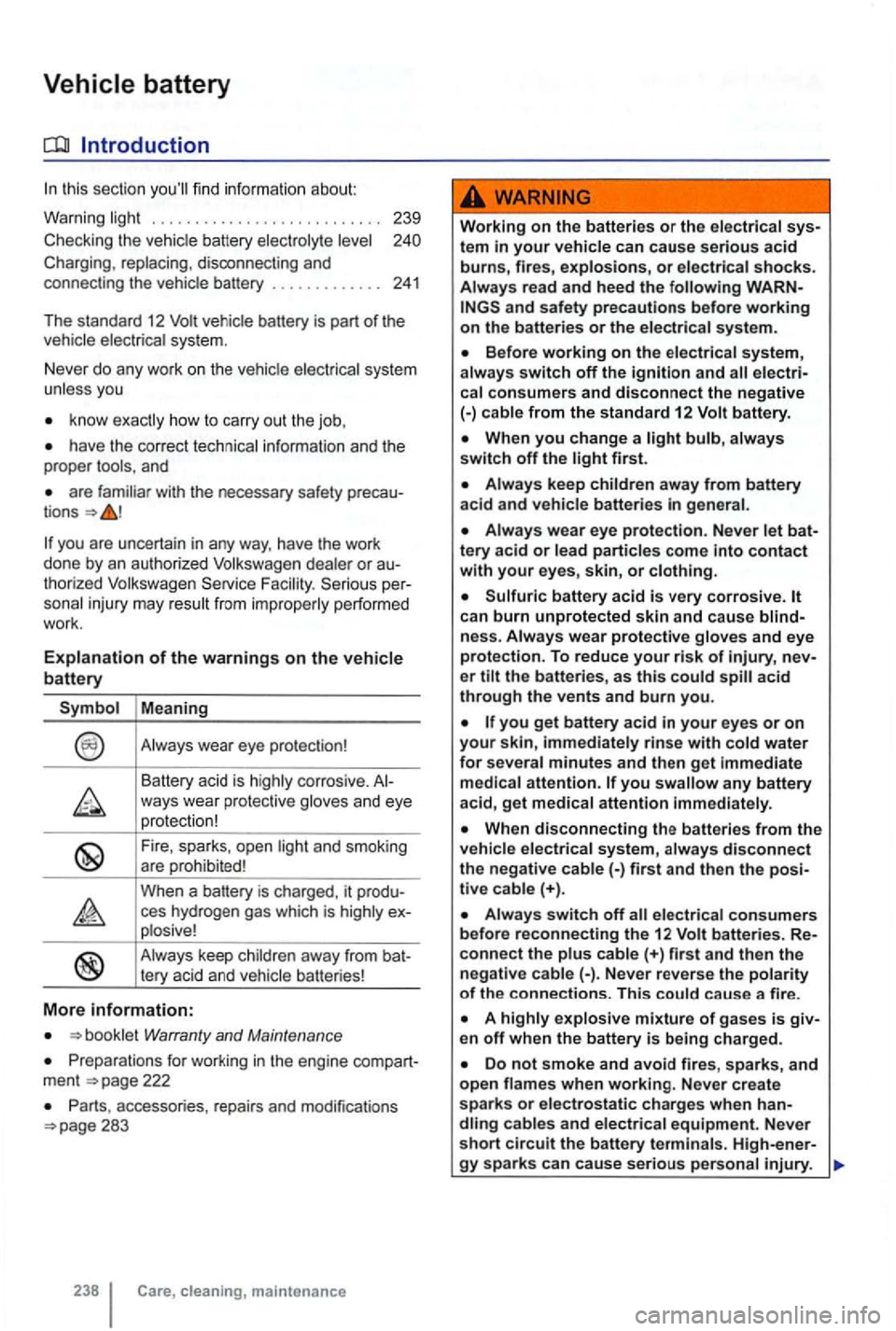
Introduction
this sec tion
b attery . . . . . . . . . . . . . 241
Th e standard 12 vehicle battery is pa rt of the
veh ic le electr ical sys te m .
N ever do any wor k on
the ve hic le elec trica l system
unl ess you
know ho w to carry out the job ,
have the correct te chn ical infor m ation an d the
p roper an d
are familiar with t he necessary safety
Faci li ty .
Meaning
A lways w
ear eye pro tec tion !
B attery acid is highl y co rrosive.
ces hydrogen gas whic h is highly
away from
Warra nty an d Maint enance
283
238 Care, cleaning, maintenance
Working on the batteries or the tem in your vehicle can cause serious acid
burn s, fires , explosions , or electrical shocks. read and heed the and safety precaution s before working on the batteries or the
switch off the ignition and
cable from the standard 12
always
switch off the light first.
batteries in
wear eye protection . Never contact with your eyes, skin, or clothing.
battery acid is very corrosive.
ness. wear protective gloves and eye
protection . To reduce your risk of injury, er acid through the vents and burn you.
you get battery acid in your eyes or on your skin , immediately rinse w ith water for minutes and then get immediate attention.
disconnect th e negative ( -) first and then the tive
switch off consumers
before reconnect ing the 12 batt eri es. connect th e cable(+) first and then the
n egative cable(-). Never reverse the polarity of the c onnections. Thi s
explo sive mixture of ga ses is en off when the battery is being charged.
e quipm ent. Never short circuit the battery terminals . High-ener-gy spark s can cause serious personal injury.
Page 338 of 516

California Proposition 65 Warning
nect 2 vehicle batteries to each other when the ignition is switched on or the engine is
tem or electronic components.
violet rays may damage the battery housing.
dam-aged by freezing .
on
Alterna tor malfun ction .
W he n t he igni tion i s sw itched on, severa l wa rnin g
a n d i ndi cato r li g ht s
come on brie fly for a functio n
check . They go out after a few seconds.
Failure to heed warning
Faci lity . H av e the
e le c tric al sys tem checked. o ff unn ecessa ry electrica l loads . The ve-batt ery
to h ee d warning or text can result in vehicle damage.
Page 339 of 516
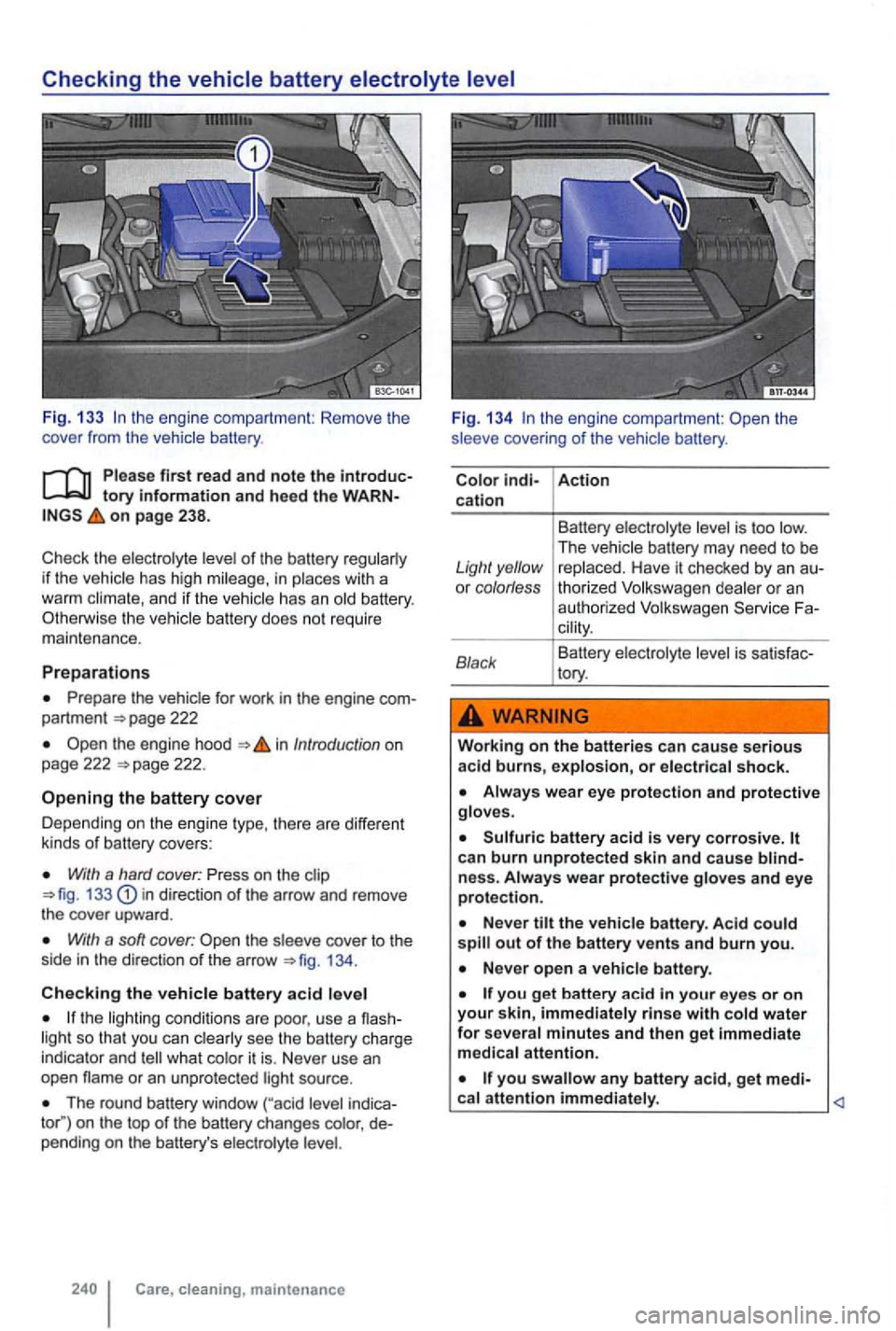
Fig. 133 the engi ne compartment: Remove the
cover from the vehicle battery.
first read and note the tory information and heed the on page 238.
of the battery if th e vehicle has high in with a
warm a nd if the vehicle has an
Prepare the for work in the engine pa rtm ent 222
the engine hood in Introduction on
page 222
With a hard cover: Press on the 133 in direct ion of t h e arrow and remove the cove r upwa rd.
W ith a son cover: the cove r to the
side in th e direction of the arrow 1 34 .
Checking the vehicle battery acid
the lighting co nd it ions are poo r, use a so tha t you can see the ba ttery charge
indica tor and
The rou nd batt ery window on th e top of the battery ch anges
Care, cleaning, maintenance Fi
g. 134
cove ring of the vehic le battery .
Action cation
Battery
is too The vehicle battery may need to be Light yellow replaced. Have it chec ked by an or colorless thorized Volkswagen or an a uthor ized Volksw ag en
is sa tisfac-
tory.
Working on the batteries can cause serious acid burns, explosion, or
can burn unprotec te d skin and cause ne ss. and eye protection.
Never out of th e battery vents a nd burn you.
Never open a vehi cle battery .
you get battery acid in your eyes or on your skin, immediately rinse with water for several minutes and t hen ge t immediate
medical attention.
you any battery acid, get medi-
Page 340 of 516
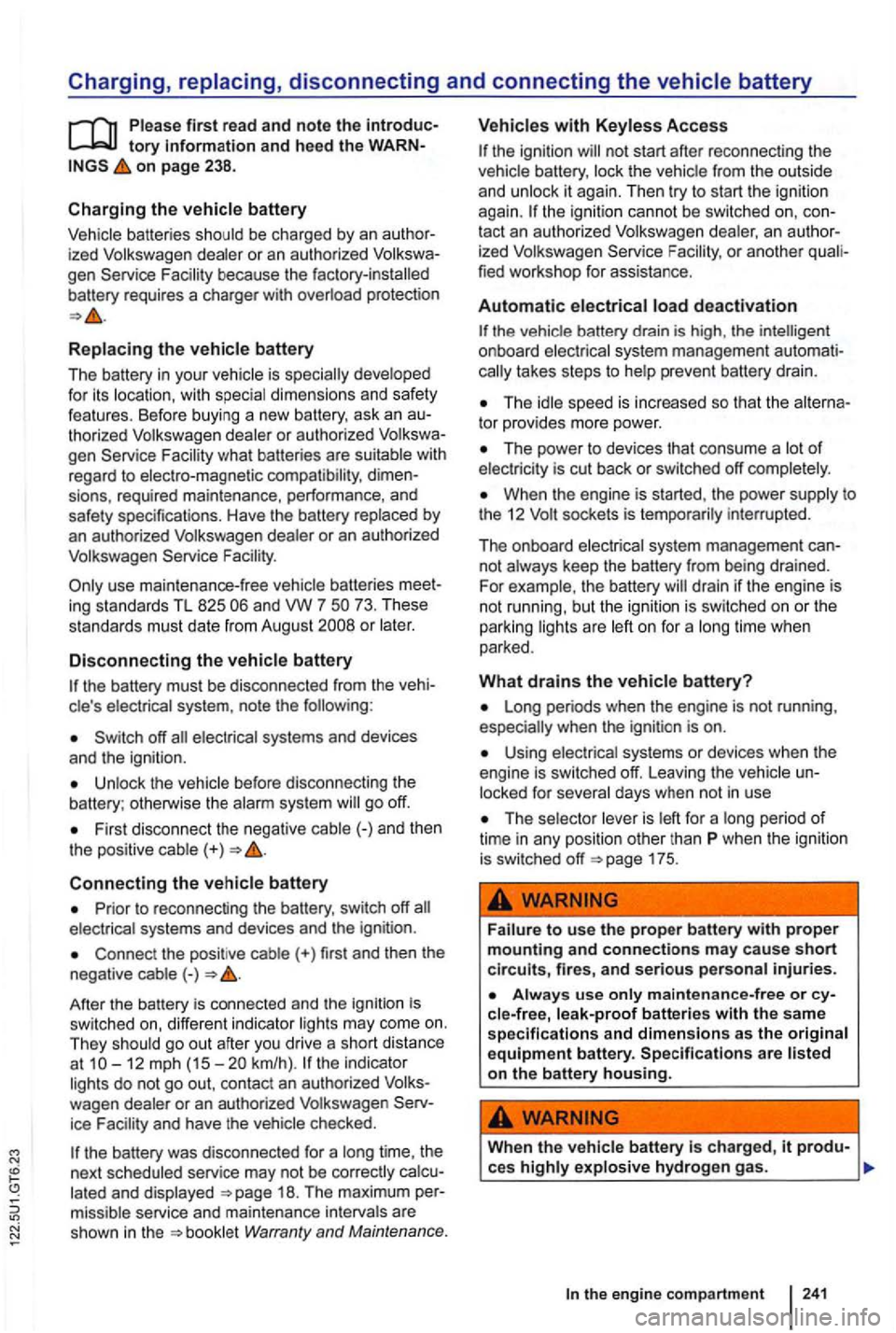
Charging,
on page 238.
Charging the vehicle battery
Vehicle batteries should be charged by an author
ized Volkswagen dealer or an authorized Volkswa
gen
because the factory -installed
battery requires a charger with overload protection
Replacing the vehicle battery
The battery in your vehicle is
batteries meet
ing standards TL 825
electrical system, note the following :
off
Unlock the vehicle before disconnecting the
battery; otherwise the alarm system
Fir st disconnect the negativ e cable(-) and then the positive
Connecting the vehicle battery
Pr ior to reconnecting the battery , switch off electrical sys tems and devices and the ignition .
Connect the posit ive cable(+) first and then the
negative cable (-)
After the battery is connected and the ignition is
sw itched on, different indicator light s may come on. They should go out after you drive a short distance
ice Facility and have the checked.
th e ign ition not start after reconnecting the vehicle battery , lock the vehic le from the outside
and unlock it again. Then try to start the ignition
again.
lhe ignition cannot be switched on, con
tact an authorized Volkswagen dealer, an author
ized Volkswagen
o r another quali
fied workshop for assistance.
Automatic electrical load deactivation
onboard electrical system management auto mati takes steps to help prevent battery drain.
The idle speed is increa sed so that the alterna
t o r provides more power.
Th e power to devices that consume a lot of electricity is cut back or switched off completely.
When the engine is started, the power supply to the 12
Long periods when the engine is not running,
especially when the ignition is on .
Using electr ical sys tems or devices when the
engine is swi tched off. Leaving the
The selecto r lever is left for a long period of time in any position other than P when the ignition
is swi tched off =>page 175.
Failure to use th e proper battery with proper mounting and connection s may cause short circu its, fires, and serious persona l injuries.
Always use only maintenance-free or cy-
cle-free, leak-proof batteries with the sa me
s p ec ifications and dimensions as the original
equipment b attery. Specifications are listed
on the battery housing.
Wh en the vehicle battery is ch arged, it produ-
ces highly explosive hydroge n gas.
th e engine compartment
Page 341 of 516
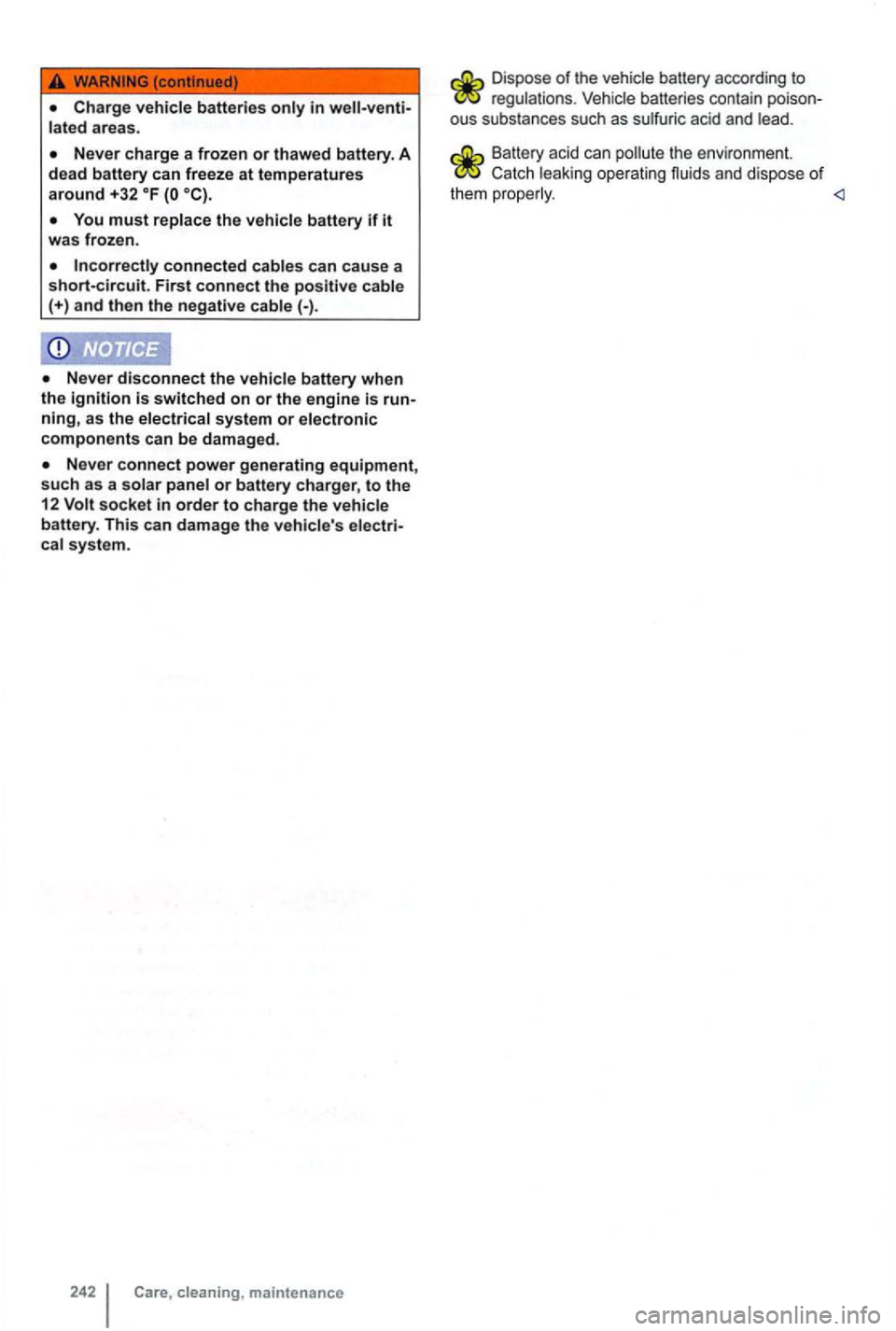
Never disconnect the vehicle battery when
th e ignition switched on or the engine is running, as the electrical system or electronic components can be damaged .
socket in order to charge the vehicle
batt ery . This can damage the vehicle's electri
cal
syst e m .
Dispose of the battery according to regulations . batteries contain poison
ous substa nces such as sulfuric acid and lead .
Battery acid can pollute the environment. Catch leaking operating fluids and dispose of
them properly.
Page 383 of 516
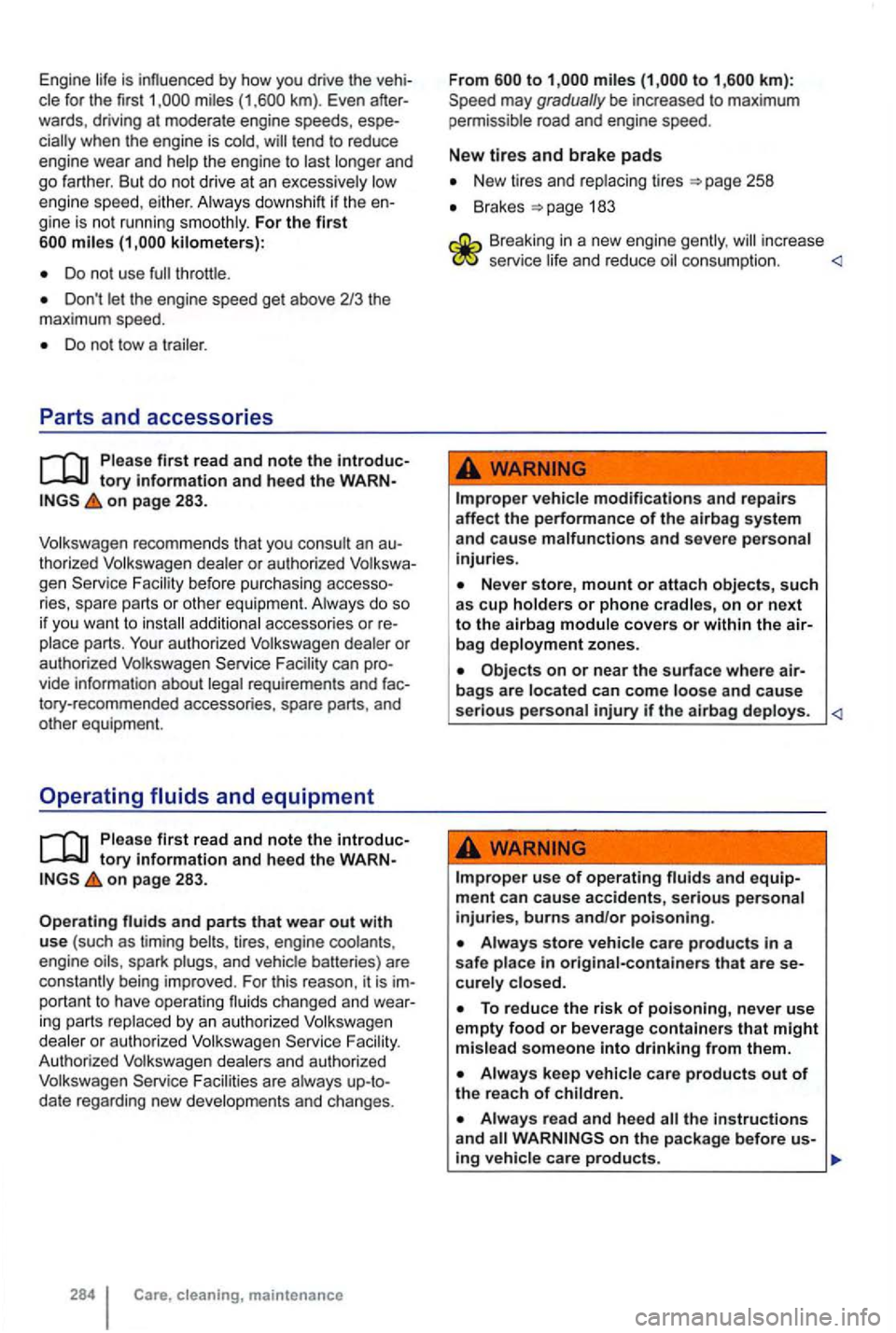
Engine life is influenced by how you drive the vehi
cle for the first miles (1 ,600 km). Even after
wards , driv ing at moderate engine speeds, espe
tend to reduce
engine wear and help the engine to last longe r and
go farther . But do not dri ve at an excess ive ly low
engi n e speed , either . A lways downshi ft if the en
gin e is not running smoothly . For the first
Do not use
Don't le t t he engine speed get above 2/3 the
max imum speed.
Do not tow a trailer .
Parts and accessories
on pag e 283.
Volkswagen recomme nds that you consult an au
tho
rized Vol kswagen dealer or authoriz ed Volkswa
gen Service Facility before purchas ing accesso
ries, spare parts or other equipment. Always do so
i f you want to
on page 283.
Operating fluids and parts that wear out w ith use (such as timing belts, tires , engine coolants ,
engine oils, spark plugs, and vehic le batteries) are
constantly being improved . For this reason, it is im
portant to have operating fluids ch anged and
wearing parts rep laced by an au thorized Volkswage n
de ale r or authorized Volk swagen Service Facility.
Authorized Volkswagen dealers and authorized
Volkswagen Service Facilities are a lways up- to
date regarding new developmen
ts and ch anges .
284 cleaning , maintenance F
rom
to
New tires and rep lacing tires 258
Brakes 183
Breaking in a new engine incr ease serv ice life and reduce oil co nsump tion.
affect the performance of the airbag system and cause malfunctions and severe personal injuries.
Improper use of operating and equipm ent can cause accidents , serious personal injuries , burns and/or poisoning.
WARNINGS on the package before us-ing vehicle care products.